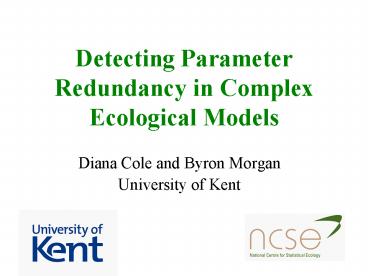Detecting Parameter Redundancy in Complex Ecological Models PowerPoint PPT Presentation
1 / 15
Title: Detecting Parameter Redundancy in Complex Ecological Models
1
Detecting Parameter Redundancy in Complex
Ecological Models
- Diana Cole and Byron Morgan
- University of Kent
2
Introduction
- If a model is parameter redundant or
non-identifiable if you cannot estimate all the
parameter in the model. - Parameter redundancy can be detected by symbolic
algebra. - Ecological models are getting more complex then
computers cannot do the symbolic algebra and
numerical methods are used instead. - In this talk we show some of the tools that can
be used to overcome this problem.
3
Example 1- Cormack Jolly Seber (CJS) Model
- Herring Gulls (Larus argentatus)
capture-recapture data for 1983 to 1987
(Lebreton, et al 1995) - ?i probability a bird survives from occasion i
to i1 - pi probability a bird is recaptured on
occasion i - ? ?1, ?2, ?3, p2, p3, p4
4
Derivative Method (Catchpole and Morgan, 1997)
- Calculate the derivative matrix D
- rank(D) 5 rank(D) 5
- Number estimable parameters rank(D).
Deficiency q rank(D) - no. est. pars 5, deficiency 6 5 1
5
Exhaustive Summaries
- An exhaustive summary, ?, is a vector that
uniquely defines the model (Walter and Lecoutier,
1982). - The exhaustive summary is the starting point for
finding the derivative matrix. - More than one exhaustive summary exists for a
model - Choosing a simpler exhaustive summary will
simplify the derivative matrix - Computer packages, such as Maple can find the
symbolic rank of the derivative matrix. - Exhaustive summaries can be simplified by any
one-one transformation such as multiplying by a
constant, taking logs, and removing repeated
terms. - For multinomial models and product-multinomial
models the more complicated 1 ? ?Qij can be
removed (Catchpole and Morgan, 1997), as long as
there are no missing values.
6
Other tools to use with exhaustive summaries
- What can you estimate? (Generalisation from
Catchpole et al, 1998.) Solve ?TD 0. Zeros in ?
indicate estimable pars. - Solve PDE to find full set of estimable pars.
- Extension theorem (Generalised from Catchpole
and Morgan, 1997.) Usefully for generalising
capture-recapture and ring-recovery models. - PLUR Decomposition. (Cole and Morgan, 2008)
Useful for detecting points at which the model is
parameter redundant or near parameter redundant,
or sub models that are parameter redundant.
7
Reparameterisation Method(Cole and Morgan, 2008)
- Choose a reparameterisation, s, that simplifies
the model structure - Rewrite the exhaustive summary, ?(?), in terms of
the reparameterisation - ?(s).
8
Reparameterisation Method
- Calculate the derivative matrix Ds
- The no. of estimable parameters min(q,rank(Ds))
- rank(Ds) 5, no. est. pars min(6,5) 5
- If Ds is full rank s sre is a reduced-form
exhaustive summary. If Ds is not full rank solve
set of PDE to find a reduced-form exhaustive
summary, sre - Ds is full rank, so s is a reduced-form
exhaustive summary
9
Reparameterisation Method
- Use sre as an exhaustive summary
- A reduced-form exhaustive summary is
- adding an extra year of capture and an extra
year of recapture adds the extra exhaustive
summary terms - Then the extension theorem can be applied to
show that the CJS is always parameter redundant
with deficiency 1.
10
Example 2 Multi-state mark-recapture models for
Seabirds
Wandering Albatross (Diomedea exulans)
- Hunter and Caswell (2008) examine parameter
redundancy of multi-state mark-recapture models,
but cannot evaluate the symbolic rank of the
derivative matrix (developed numerical method) - 4 state breeding success model
1
3
4
2
breeding given survival
successful breeding
survival
capture
11
Reparameterisation Method
- Choose a reparameterisation, s, that simplifies
the model structure - Rewrite the exhaustive summary, ?(?), in terms of
the reparameterisation - ?(s).
12
Reparameterisation Method
- Calculate the derivative matrix Ds
- The no. of estimable parameters min(p,rank(Ds))
- rank(Ds) 12, no. est. pars min(14,12) 12
- If Ds is full rank s sre is a reduced-form
exhaustive summary. If Ds is not full rank solve
set of PDE to find a reduced-form exhaustive
summary, sre
13
Reparameterisation Method
- Use sre as an exhaustive summary
Breeding Constraint Survival Constraint Survival Constraint Survival Constraint Survival Constraint
Breeding Constraint ?1 ?2 ?3 ?4 ?1 ?3, ?2 ?4 ?1 ?2, ?3 ?4 ?1, ?2, ?3,?4
?1 ?2?3 ?4 0 (8) 0 (9) 1 (9) 1 (11)
?1 ?3,?2 ?4 0 (9) 0 (10) 0 (10) 2 (12)
?1 ?2,?3 ?4 0 (9) 0 (10) 1 (10) 1 (12)
?1,?2,?3, ?4 0 (11) 0 (12) 0 (12) 2 (14)
14
Conclusion
- Exhaustive summaries can be used to detect
parameter redundancy. - The key to more complex problems is to find the
exhaustive summary with the simplest structure. - The most powerful method of finding an exhaustive
summary is the reparameterisation method which
examines the basic building blocks of the model. - These methods can be applied to any parametric
model.
15
References
- Catchpole, E. A. and Morgan, B. J. T. (1997)
Detecting parameter redundancy. Biometrika, 84,
187-196 - Catchpole, E. A., Morgan, B. J. T. and Freeman,
S. N. (1998) Estimation in parameter redundant
models. Biometrika, 85, 462-468 - Hunter, C.M. and Caswell, H. (2008). Parameter
redundancy in multistate mark-recapture models
with unobservable states. Ecological and
Environmental Statistics - in press - Cole, D. J. and Morgan, B. J. T (2008) Parameter
Redundancy and Identifiability. University of
Kent Technical Report UKC/IMS/08/022 - Lebreton, J. Morgan, B. J. T., Pradel R. and
Freeman, S. N. (1995) A simultaneous survival
rate analysis of dead recovery and live recapture
data. Biometrics, 51, 1418-1428. - Walter, E. and Lecoutier, Y (1982) Global
approaches to identifiability testing for linear
and nonlinear state space models. Mathematics and
Computers in Simulations, 24, 472-482

